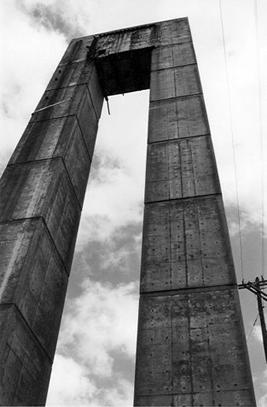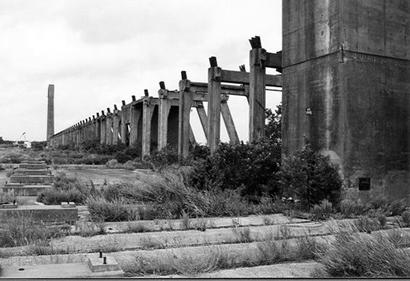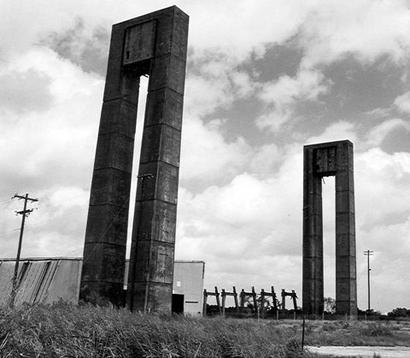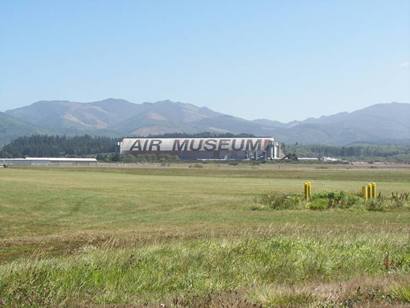|
 |
History
in a Blimp Hanger
The
Hitchcock Naval Air Station was a blimp base used for spotting German
submarine activity during WWII. The 3,000 acre base was within the
city limits of Hitchcock
and construction began in 1942. The blimp hanger which held six aircraft
was built for the astounding cost of $10 million. Dimensions of the
hanger was 1,000 feet long by 300 feet wide and 200 feet high. Floor
space was 300,000 square feet.
The base which had a complement of only 143 officers and crew - was
commissioned in May of 1943. Beside the hanger were auxiliary buildings
including barracks, warehouses, a mess hall, gymnasium, auditorium
and an Olympic-size swimming pool which was used to teach swimming
and water-rescue. The base was hit by a June hurricane that year but
received minimal damage.
The German U-boat wolfpacks which mainly operated around the Florida
straits reduced their presence in 1943. The construction of the Intra-Coastal
Waterway and increased escorts made the kill-ratio not worth the effort.
Many of the other LTA (Lighter-than-Air) stations were closed but
Hitchcock
became a depot for storing surplus or inactive aeronautical material.
The base was sold as war surplus in 1949 for the bargain basement
price of $143,777. It was used for storing rice at one point and it
was said that the entire rice crop of Texas could have been stored
in the hanger. The building was then bought by John W. Mecom who leased
the building during the Korean War, to remanufacture half-track vehicle
and WWII tanks for use in the Korean War. Hurricane Carla damaged
the building in 1961 to the point where it couldn't be repaired and
it was demolished the following year. |
CAMP
WALLACE
The
Naval base at Hitchcock started out as an antiaircraft training center
in February 1941. The camp was named to honor Col. Elmer J. Wallace
of the Fifty-ninth Coast Artillery, who had been killed in WWI.
For two years it served as an antiaircraft replacement training center
was then transferred to the United States Navy as a naval training
and distribution center. After the war it became a discharge facility
for Navy personnel.
Letter from W.T.
Block, Nederland, Texas:
I was in anti-aircraft artillery at Camp Wallace from '42 to '43.
I taught radio operating and maintenance in the schools there. I often
had to take radio operators out on 2 week bivouac and for gunnery
practice at the beach. We were often down at Galveston's
Stewart Beach firing 40 and 90 mm (3 1/2" barrel) AA guns, and .30
and .50 cal AA machine guns. Also firing bazookas, throwing grenades,
running infiltration courses under machine gun fire, etc. I had to
take basic infantry training for 8 weeks twice, since the Infantry
would not accept my AA training. I was transferred to 78th Infantry
in Dec '43 while on Tenn 2nd Army manuevers and spent, much of '44
and all of '45 in England, France and Germany.
I also remember large pecan orchards there. During the 1950s weekly
delivery trucks used to pass through my town of Nederland with the
motto: "Nuts to you from the Hitchcock Pecan Company." - W.T.
Block, Nederland,
Texas, March 31, 2007 |
 |
 |
Impressions
of the base ruins in September 2000
Photographer's Note:
"Outside
Hitchcock
are the remains of a blimp air base used in World War II when blimps
patrolled the Gulf coast for German submarines. It's private property
now - a coating company has a building there, but you can look around
(but remembering it is private property). It's eerie walking among
these huge abandoned towers. There are four towers. I don't know how
tall they are but I'm guessing maybe 200 feet. And there are skeletal
remains of a building that ran between two towers. The only things
left are the supporting beams that stretch for nearly three hundred
yards. Exactly how they used the towers I don't know. I would've loved
to go inside the towers and climb up, rung by rung, to the top. Actually
I would have been terrified, but more curious than terrified. Alas,
when I checked each tower the door was locked. But you can look inside
and see miscellaneous junk stored from the coating company, and the
rungs leading up the tower. A hundred yards from the towers is a huge
concrete area. I'm not sure how the air base used that area, but nowadays
it is being used by a go-cart club; and today I heard carts buzzing
like huge mosquitoes.
I felt like I was transported back in time. Black and white newsreels
that I carry in my mind from hundreds of TV documentaries were suddenly
in color and three dimensions. If this were a movie I would look up
and see a jaunty young fellow walking toward me. He would look and
sound snappy but vaguely out of style although I wouldn't notice it
much as he eagerly shows me around and he seems to know this place
like.... and just as suddenly he's gone and I would have a ghost story
to tell. In real life I met up with an old boy in a ball cap and pickup
truck who asked me in a slightly irritated tone what I was doing there.
He's the owner of the coating company and just wants to keep tabs
on folks who wander through." - William
Holmes, Arlington, Texas, February 28, 2007 |
Forum
I
was really intrigued with the Hitchcock Naval Air Station article
by William Holmes having just recently read its Historical Marker
in the 'Why Stop?' book. I dismissed the idea that it should go on
the 'Must See Wish List' because the Marker stated that 'after hurricane
damage in 1961 the blimp hangar was razed.' The hangar, yes. But not
the massive door hangers. |
Former Naval
"Blimp" Hangar (now the Tillamook Air Museum) shows what
the Hitchcock hangar would've looked like in its heyday.
Photo
Courtesy Barclay
Gibson, 2006 |
Anyway, I immediately
knew what the structures were because similar blimps hangars were
built on the Oregon coast near Tillamook in WWII,
now housing the Tillamook Air Museum. In the closeup picture (above)
you can see the huge concrete door hangars on the end of the hangar.
I'd bet each door weighed more than a blimp did. It must be the last
blimp hangar left as it is now billed as the largest wooden structure
in the world. Nearby are two pillars just like the ones pictured by
Mr Holmes, where four bare concrete door hangars are still standing.
When you realize that these are just the door hangers, the hangar
itself was truly massive. Google Earth has excellent aerial pictures
of the Hitchcock pillars which show up well because of the long shadows
they project in the afternoon sun.
Hitchock Naval Air Station is now on [my] 'Must See Wish List.' Thanks
again. - Barclay
Gibson, April 02, 2007 |
 |
The Tillamook
Air Museum from a distance showing its extraordinary length.
Photo Courtesy Barclay
Gibson |
|
|
